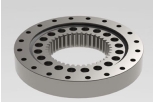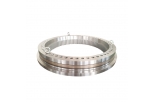Bearing Selection
Selection determines the correct dimensioning of bearing races, gearing and bolt connections.
We, therefore require that you complete our Application Questionnaire to provide us with all necessary data to help in selection of the appropriate bearing.
The most important data for choosing the right bearing are:
1. Applied loads
2. Collective loads with respective time percentages
3. Speed or number of movements and angle per time unit together with the relating collective loads
4. Circumferential forces to be transmitted by the gearing
5. Bearing diameter
6. Other operating conditions.
Full completion of the Application Questionnaire will enable us to largely respect your requests and prepare a technically adequate and economical bearing proposal.
Whenever possible, the completed Application Questionnaire should be submitted to us during the planning stage, but no later than the order placement to allow for confirmation of the bearing.
Load capacity:
Generally, when the rotational diameter and section dimension are same then the static load capacity from high to low is:
Three-row roller bearing;
Four-point contact ball bearing;
Cross roller bearing.
Double-row ball bearing.
When the dynamic loading capacities are taken into account therankings are as follows:
Three-row roller bearing;
Cross roller bearing;
Four-point contact ball bearing;
Double-row ball bearing.
Service life
In slewing bearing technology, theoretical life is a well-known term. Due to a multitude of influential factors, nominal life acc. to DIN/ISO 281 cannot in practice be taken as an absolute value but as a reference value and design guide. Not all bearings will reach their theoretical life, although most will generally exceed it, often by several times.
Theoretical life criteria cannot be applied directly to large-diameter bearings, particularly with bearings performing intermittent slewing motions or slow rotations.
In most applications the speed of rotation in the race will be relatively low. Therefore, the smooth operation and precise running of the bearing are not adversely influenced by wear or by the sporadic occurrence of pittings. It is, therefore, not customary to design large-diameter bearings destined forslewing or slow rotating motion on the basis of their theoretical life. For better definition, the term "service life" was introduced. A bearing has reached its service life when torque resistance progressively increases, or when wear phenomena have progressed so far that the function of the bearing is jeopardized.
The service life determined with the aid of the curves shown is only valid for bearings carrying out oscillating motions or slow rotations. This method is not applicable to:
bearings for high radial forces,
bearings rotating at high speed,
bearings having to meet stringent precision requirements.
In such cases TENZE will carry out the calculations based on the load spectra including the speed of rotation and percentage of operating time.
We must clearly distinguish between the operating hours of the equipment and the actual rotating or slewing time. The various loads must be taken into account in the form of load spectra and percentages of time. For service life considerations another influential factor not to be neglected is the slewing angle under load and without load.
For an approximate determination of the service life of a bearing, service life curves are shown next to the static limiting load diagrams. This does not apply to Single row ball bearing and light profile bearing.
These service life curves are based on 30,000 revolutions under full load. They can also be employed to determine the service life with different load spectra or to select a bearing with a specified service life.
Working Temperature
The normal operating temperature is -20℃~70℃ and it is possible to be extended to -40℃~200℃ by special design.










